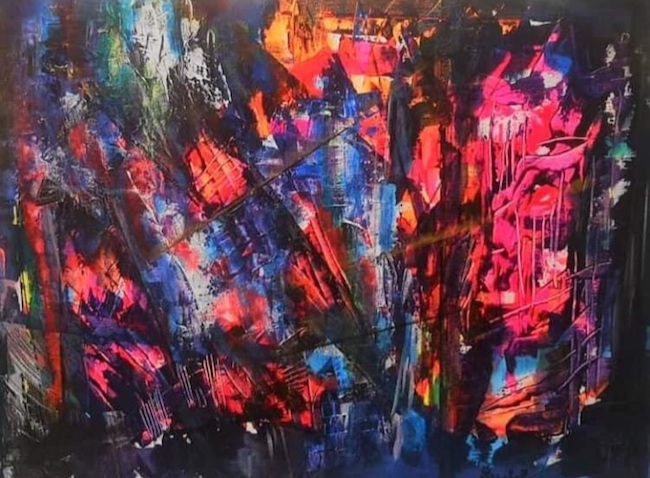L’immersione nelle proprie sensazioni, nelle paure, nelle ansie che contraddistinguono il vivere contemporaneo, è un processo particolare di consapevolezza e di accoglimento delle sensazioni più profonde che molti artisti hanno il bisogno di affrontare proprio per liberarsi dalle proprie gabbie interiori e al tempo stesso indicare all’osservatore, anch’egli protagonista di questo tempo, che esiste un modo per uscire dalle inquietudini e l’arte può dunque costituire il mezzo affinché quel processo abbia inizio. Alcuni creativi affrontano l’argomento in maniera più morbida mentre altri hanno bisogno di farsi trasportare dal turbinio di sensazioni per poi trovare quell’equilibrio che si conquista solo dopo averlo perduto. La protagonista di oggi appartiene a questa seconda categoria di artisti e conduce l’osservatore a comprendere l’importanza dell’oscurità per trovare la propria personale luce.
Il mondo delle emozioni ha trovato la sua collocazione ideale in quel periodo a cavallo tra Ottocento e Novecento in cui l’arte non poteva più continuare a essere semplicemente riproduzione estetica delle immagini e dei personaggi immortalati perché altrimenti sarebbe rimasta al di fuori, decontestualizzata dal dinamismo di un periodo che correva veloce dal punto di vista tecnologico ma che spaventava e intimoriva a causa delle continue rivoluzioni, a partire da quella Industriale, e dei venti di guerra che si affacciavano all’orizzonte. A partire dall’Espressionismo il mondo emozionale cominciò addirittura a prevalere su quello formale, al punto che non doveva più essere la sostanza ad adattarsi alla forma, al contrario la forma si adeguava completamente all’intensità e alla profondità della sostanza, sia dal punto di vista cromatico che da quello figurativo perché tutte le regole accademiche su cui si era basata l’arte precedente erano crollate davanti alla priorità di narrare il mondo interiore. In particolar modo fu l’Espressionismo nordico a liberare incisivamente le tempeste interiori, le paure che immobilizzavano l’uomo di quei tempi; uno fra tutti Edvard Munch il quale con le sue atmosfere cupe e in alcuni casi tetre rappresentò in maniera magistrale le angosce, le inquietudini, la paura della distruzione e della dissoluzione di tutto il conosciuto che aleggiava in Europa. Con il procedere del Ventesimo secolo e con l’approfondimento da parte di altre correnti artistiche dell’aspetto emozionale, psicologico, interiore od onirico, l’attenzione sull’individuo divenne maggiore al punto di prevalere, in alcuni casi, su qualsiasi forma osservata giungendo così alla scomposizione totale che vide il suo culmine con l’Espressionismo Astratto, un’evoluzione di tutti i precedenti stili pittorici che rifiutavano l’aderenza alla realtà oggettiva ma che si distaccavano anche dal sentire dell’esecutore dell’opera; nel movimento di cui fu fondatore e principale esponente Jackson Pollock invece, l’unica linea guida doveva essere la manifestazione espressiva, la liberazione di un’interiorità di cui la tela doveva essere prolungamento delle sensazioni avvertite, in qualsiasi modo decidessero di manifestarsi. Ecco dunque spiegato il motivo delle differenze profonde tra le opere irruente e impulsive di Pollock e quelle riflessive e silenziose di Mark Rothko, tra la leggerezza quasi impalpabile di Cy Twombly e l’incisività cromatica di Clyfford Still per finire con la vivacità coloristica di Hans Hofman e di Helen Frankenthaler. L’artista francese Annabelle Ferreira interpreta l’Espressionismo Astratto come un viaggio all’interno della sua interiorità, di quelle emozioni inconsapevoli che possono manifestarsi solo dopo essersi immersa all’interno del groviglio di sensazioni che fluttua nell’animo e che non riesce a fuoriuscire se non dopo un percorso di autoconsapevolezza, di presa di coscienza della necessità di avere a che fare prima con le ombre, con il sommerso, con tutto ciò che altrimenti non giungerebbe in superficie.
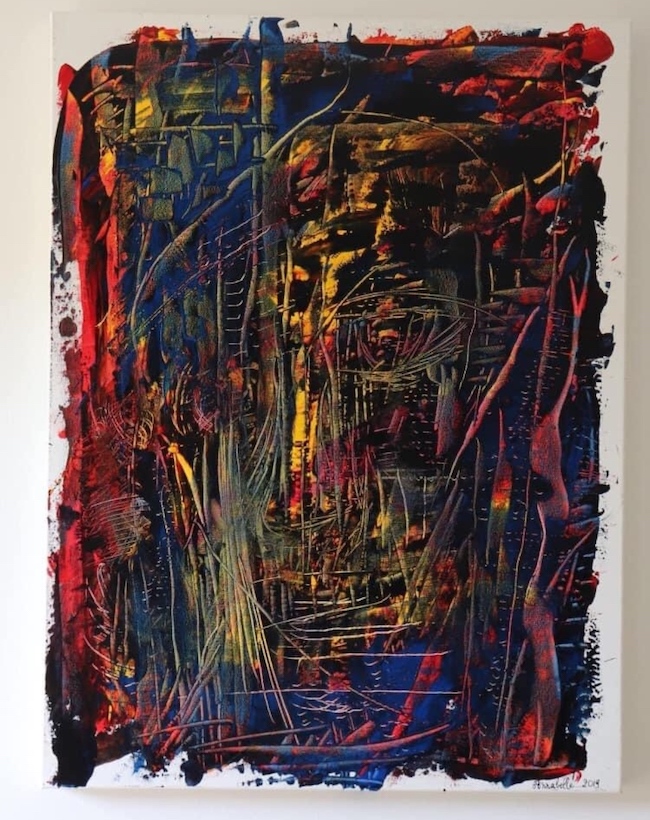
Le tonalità scelte dall’artista sono perciò funzionali al suo intento creativo, sembrano accompagnare il flusso emozionale, il cammino all’interno di un sé che sa perfettamente di dover scendere nelle profondità che a volte fanno persino paura, se vuole raggiungere la luce che appartiene alla forza in grado di emergere solo dopo aver scoperto e vinto la debolezza.
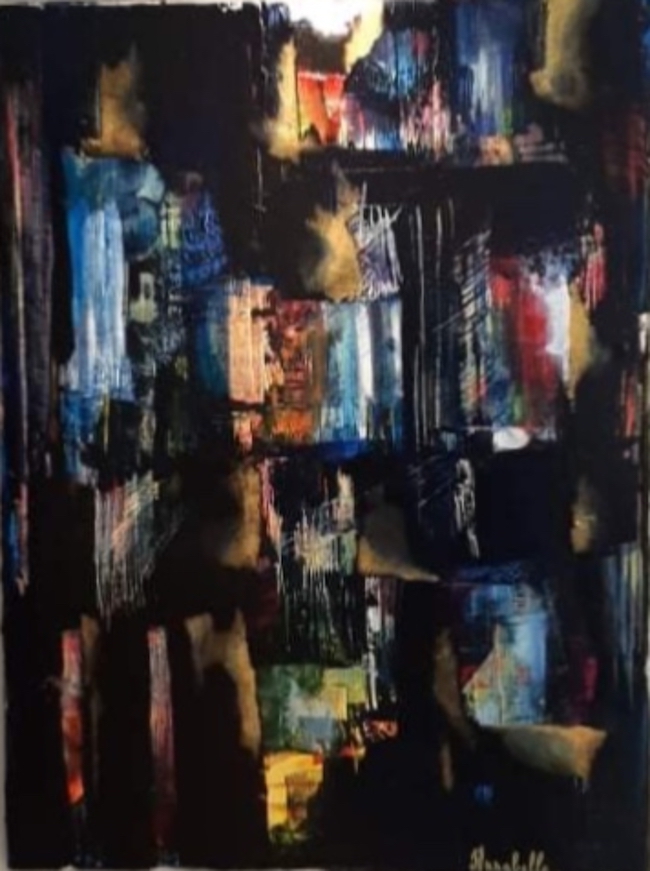
La ricerca del legame che unisca le contraddizioni appartenenti all’essere umano e che troppo spesso vengono viste e percepite come una spiacevole dissonanza, costituisce il fulcro della pittura di Annabelle Ferreira, per la quale invece la bellezza risiede nella la possibilità di crescita che si sviluppa proprio in quel dualismo che permette all’essere umano di mettersi in discussione e di trovare il modo di superarlo, oltrepassare l’ostacolo e tendere verso la luminosità che può manifestarsi solo dopo aver compreso a fondo le ragioni delle ombre.
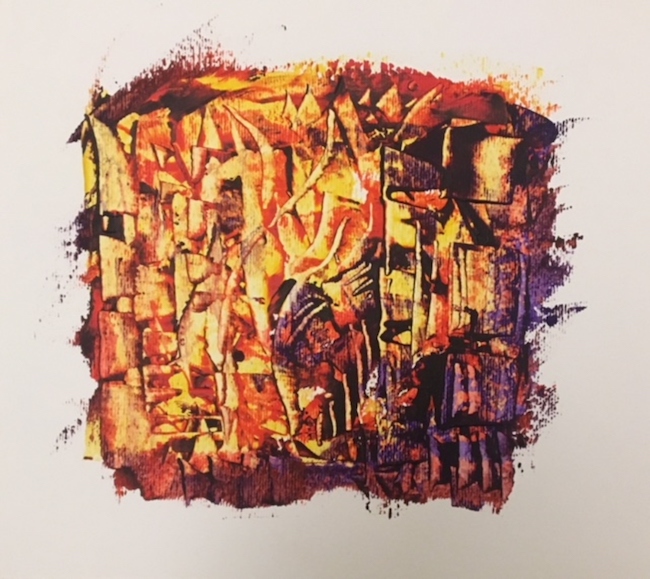
In virtù di questo tipo di approccio, di questo bisogno di camminare sulla linea sottile tra buio e luce, l’artista sceglie di ispirarsi alle sfaccettature delle vetrate colorate per le sue opere, proprio per suggerire all’osservatore quanto tutto ciò che sembra insuperabile, cupo, tormentato, in realtà nasconda in sé il seme per trovare una via d’uscita, un superamento e una risalita verso la positività.
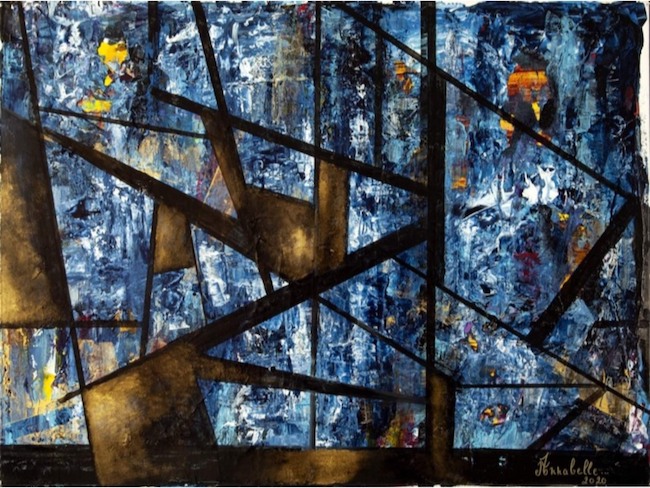
L’opera Vitrail bleu, le sacré du féminin et du masculin (Vetro colorato blu, il sacro del femminile e del maschile) racconta in maniera molto evidente il contrasto tra ombre e chiarezza, tra ciò che appartiene all’interiorità spesso nascosta perché bisognosa di essere protetta, e ciò che al contrario viene mostrato all’esterno, come se fosse un’armatura lucente in grado di far apparire il proprio lato migliore; oltre ciò tuttavia è possibile intravedere anche quelle venature, quegli scorci verso le profondità che l’artista nel titolo definisce sacre e che costituiscono l’essenza, la vera natura che si svela solo a chi è in grado di guardare oltre quell’apparenza lucente. Le sfaccettature dell’Espressionismo Astratto contraddistinguono le differenze ma anche le similitudini tra maschile e femminile, quel sentire emozionale che non ha colore, non ha sesso, non ha distanza ed è esattamente il punto di congiunzione al livello del quale porsi in posizione di dialogo.
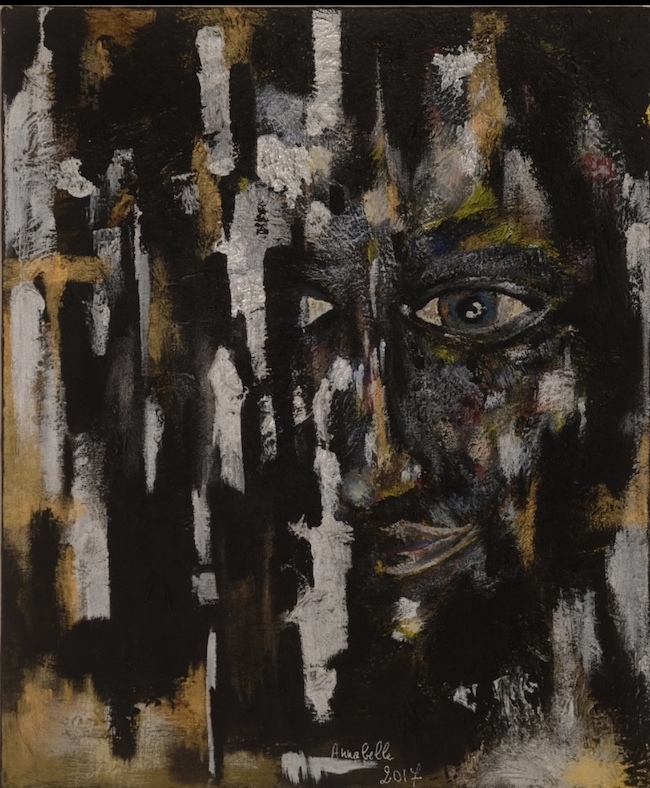
Il medesimo tema della tendenza dell’uomo a celare, molto più della donna, la propria sensibilità, la propria interiorità, è ripreso nella tela Alter ego masculin (Alter ego maschile), in cui lo sguardo del soggetto emerge da veli sovrapposti, da strati di barriere che lo proteggono dall’esterno, che lo rendono duro all’apparenza, durezza rappresentata dal nero della base predominante della tela, ma che poi, andando a spostare quelle cortine fumose dietro cui si nasconde, svela una dolcezza inaspettata narrata attraverso uno sguardo limpido e un sorriso quasi timido. Anche in quest’opera Annabelle Ferreira va a ricercare la chiave di lettura di una realtà apparente, non si ferma alla superficie bensì va in fondo, squarcia l’oscurità e ricerca tutto ciò che è sotto la coltre del visibile.
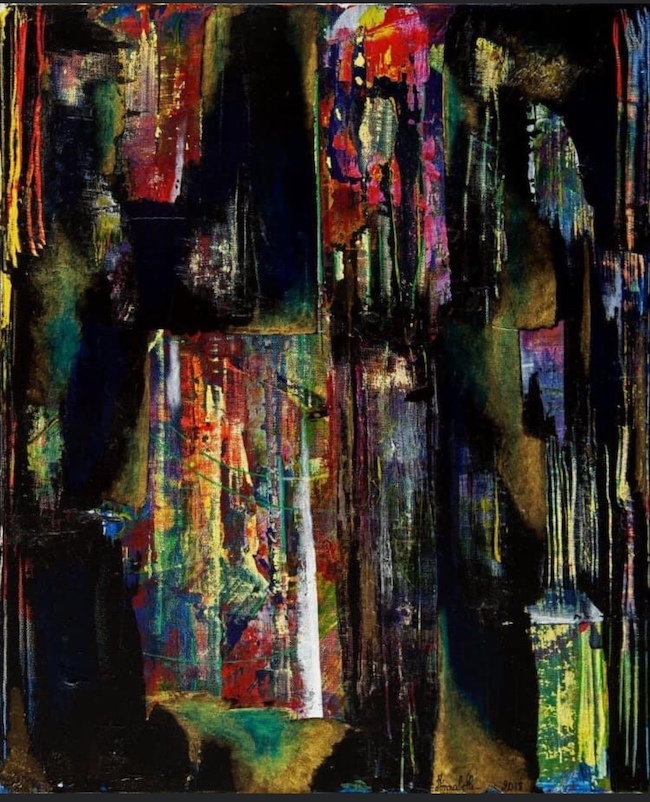
La sua caratteristica di allungare lo sguardo per indagare su tutto ciò che la maggior parte delle persone non vede, emerge anche in Dans l’obscurité (Nell’oscurità), tela in cui ancora una volta è il nero a fare da base, colore prevalente nelle opere dell’artista, ma non permane a dominare perché lascia spazio a ciò che fa sentire la sua voce solo a seguito di un attento ascolto, e così tutte le tonalità che fanno parte dell’esistenza si manifestano, squarciano il buio per mostrarsi in tutta la loro vivacità, in tutta la loro poliedricità cromatica tanto numerosa quanto lo sono i frammenti di emozione che attraversano continuamente la quotidianità e l’esistenza. Malgrado un’iniziale sensazione cupa derivante dalle atmosfere scure delle sue tele, Annabelle Ferreira mostra invece una filosofia di vita positiva, intimista certo, introspettiva senza dubbio, ma in grado di trovare il lato positivo di qualsiasi esperienza, di ogni persona su cui si posa il suo sguardo attento e sensibile.
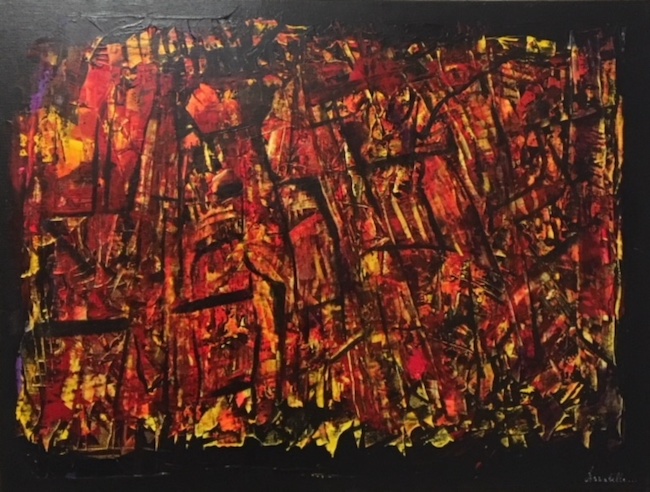
Annabelle Ferreira inizia la sua carriera nel campo dell’arte come designer di luci per il teatro e creatrice di marionette ma nel 2017 il richiamo verso l’espressione pittorica diviene sempre più forte, così come l’impulso ad ascoltare se stessa, il proprio istinto, la propria sensibilità che ha bisogno dell’indefinito, dei colori, della tela per trovare la sua dimensione espressiva. Espone regolarmente in Francia ed è rappresentata dalla galleria Artechcorner di Noyon.
ANNABELLE FERREIRA-CONTATTI
Email: annabellecreations@icloud.com
Facebook: https://www.facebook.com/annabelle.ferreira.10
https://www.facebook.com/artspeinturescreations/
Instagram: https://www.instagram.com/annabelle.ferreira/
The discovery of light after the crossing of darkness in Annabelle Ferreira’s Abstract Expressionism
Immersion in one’s own sensations, fears and anxieties that characterise contemporary life is a particular process of awareness and acceptance of the deepest feelings that many artists need to face to free themselves from their inner cages and at the same time show the observer, who is also a protagonist of this time, that there is a way out of their anxieties, and art can therefore be the means for this process to begin. Some creatives approach the subject in a softer way, while others need to let themselves be carried away by the whirlwind of sensations in order to find the balance that can only be achieved after losing it. Today’s protagonist belongs to this second category of artists and leads the viewer to understand the importance of darkness to find his own personal light.
The world of emotions found its ideal place in that period between the 19th and 20th centuries in which art could no longer continue to be simply the aesthetic reproduction of the images and characters immortalised because otherwise it would have remained outside, decontextualised from the dynamism of a period that ran fast from a technological point of view but which frightened and intimidated because of the continuous revolutions, starting with the Industrial Revolution, and the winds of war that were appearing on the horizon. Starting with Expressionism, the emotional world even began to prevail over the formal one, to the point that it was no longer the substance that had to adapt to the form, on the contrary the form adapted itself completely to the intensity and depth of the substance, both chromatically and figuratively, because all the academic rules on which previous art had been based collapsed before the priority of narrating the inner world. In particular, it was Nordic Expressionism that incisively released the inner storms and fears that immobilized man in those times; one of these was Edvard Munch, whose dark and sometimes gloomy atmospheres masterfully represented the anguish, anxiety, fear of destruction and dissolution of all that was known in Europe.
As the 20th century progressed and other artistic currents took a closer look at the emotional, psychological, inner or dream aspect, the focus on the individual became greater, to the point of prevailing, in some cases, over any observed form, leading to the total decomposition that culminated in Abstract Expressionism, an evolution of all previous painting styles that refused to adhere to objective reality but also detached themselves from the feelings of the artist; in the movement of which Jackson Pollock was the founder and main exponent, on the other hand, the only guideline was to be the expressive manifestation, the liberation of an interiority of which the canvas was to be an extension of the sensations felt, in whatever way they decided to manifest themselves. This explains the profound differences between Pollock’s impetuous and impulsive works and Mark Rothko’s reflective and silent ones, between Cy Twombly’s almost impalpable lightness and Clyfford Still’s chromatic incisiveness, and finally the colourful vivacity of Hans Hofman and Helen Frankenthaler. The French artist Annabelle Ferreira interprets Abstract Expressionism as a journey into her inner self, into those unconscious emotions that can only manifest themselves after she has immersed in the tangle of sensations that floats in the soul and that can only come out after a path of selfconsciousness, of awareness of the need to deal first with the shadows, with the submerged, with everything that would otherwise not reach the surface. The shades chosen by the artist are therefore functional to her creative intent, and seem to accompany the emotional flow, the journey within a self that is perfectly aware of having to descend into the depths that are sometimes even frightening, if it wants to reach the light that belongs to the strength which can emerge only after having discovered and overcome weakness. The search for the bond that unites the contradictions belonging to the human being, which are all too often seen and perceived as an unpleasant dissonance, is at the heart of Annabelle Ferreira’s painting. For her, however, beauty lies in the possibility of growth that develops precisely in that dualism that allows the human being to question himself and find a way to overcome it, to cross the obstacle and strive towards the luminosity that can only come about after having fully understood the reasons for the shadows.
By virtue of this type of approach, this need to walk on the thin line between darkness and light, the artist chooses to draw inspiration from the facets of stained glass for her artworks, precisely to suggest to the observer how everything that seems insuperable, gloomy, tormented, in reality hides within itself the seed to find a way out, to overcome and ascent to positivity. The artwork Vitrail bleu, le sacré du féminin et du masculin (Blue stained glass, the sacred of the feminine and masculine) is a very clear illustration of the contrast between shadows and clarity, between what belongs to the inner self, often hidden because it needs to be protected, and what, on the contrary, is shown to the outside, as if it were a shining armour capable of revealing its best side; beyond this, however, it is also possible to glimpse those veins, those foreshortening into the depths that the artist defines sacred in the title and that constitute the essence, the true nature that is revealed only to those who are able to look beyond that shiny appearance. The facets of Abstract Expressionism distinguish the differences but also the similarities between male and female, that emotional feeling that has no colour, no sex, no distance and is exactly the point of conjunction at which to place oneself in a position of dialogue. The same theme of the tendency of men to conceal their sensitivity, their interiority, much more than women, is taken up in the painting Alter ego masculin (Masculine Alter Ego), in which the subject’s gaze emerges from overlapping veils, from layers of barriers that protect him from the outside world, that make him apparently hard, hardness represented by the blackness of the predominant base of the canvas, but then, by shifting those smoky curtains behind which it hides, it reveals an unexpected gentleness narrated through a clear gaze and an almost shy smile.
In this artwork, too, Annabelle Ferreira searches for the key to interpreting an apparent reality, she does not stop at the surface, but goes to the bottom, rips open the darkness and searches for everything that lies beneath the blanket of the visible. Her characteristic of stretching out her gaze to investigate everything that most people do not see also emerges in Dans l’obscurité (In the dark), a painting in which black once again forms the basis, the predominant colour in the artist’s work, but does not remain to dominate because it leaves room for what makes its voice heard only after careful listening, and so all the tones that are part of existence manifest themselves, piercing the darkness to show themselves in all their vivacity, in all their chromatic versatility, as numerous as the fragments of emotion that continually cross everyday life and existence. Despite an initial gloomy sensation deriving from the dark atmospheres of her canvases, Annabelle Ferreira instead shows a positive philosophy of life, intimist of course, introspective no doubt, but able to find the positive side of any experience, of every person on whom her attentive and sensitive gaze rests. Annabelle Ferreira began her career in the field of art as a lighting designer for the theatre and puppet creator, but in 2017 the call to express herself as a painter became stronger and stronger, as did the impulse to listen to herself, her instinct, her sensitivity, which needs the indefinite, colours and canvas to find its expressive dimension. She exhibits regularly in France and is represented by the Artechcorner gallery in Noyon.


